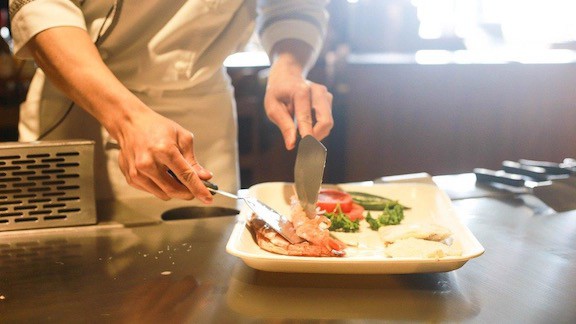Standardizing Menu Cycles for Senior Dining

Many communities in the senior living industry struggle with the task of creating a sustainable, nutritious, and varied menu cycle for their residents.
It’s understandable. Navigating the unique dietary requirements and preferences of seniors while balancing operational efficiency can feel like walking a tightrope.
But it doesn't have to be. The secret to solving this conundrum and elevating the resident experience is shifting from static menus to a standardized menu cycle.
What is a standardized menu cycle, and how does it benefit senior living communities? And what does it take to create a successful one? This guide answers these important questions.
The Benefits of Creating a Standardized Menu Cycle
In essence, a standardized menu cycle is a systematic approach to meal planning that incorporates varied, nutritious, and appetizing dishes over a specific period - typically a week or a month. One common example is a four-week cycle where meals rotate on a monthly basis, serving residents diverse meals that won't get boring.
Creating a standardized menu cycle for senior living dining will boost revenue, increase staff efficiency, and improve the resident experience.
Here’s how:
Improved resident satisfaction and engagement
The most important benefit of a standardized menu cycle is that it greatly improves the customer experience for residents. A rotating cycle guarantees consistency in the quality, portion size, and nutritional value of the meals. It also gives residents the opportunity to anticipate and look forward to their favorite meals. Finally, it can be a conversation starter among residents, and communities can foster community engagement by involving the residents in the menu planning process.
A balanced and diverse dietary intake
Crafting a standardized menu cycle ensures that seniors receive sufficient proteins, vitamins and minerals, and healthy fats. Strategically planning to include these vital nutrients over the course of the cycle ensures that every meal contributes to a balanced dietary intake.
Simplified meal preparation
A simplified senior dining menu cycle gives kitchen staff a clear direction and plan. It gets rid of the daily scramble of deciding what to cook and ensures that chefs have all the required meal components when needed. It also improves efficiency in the kitchen since staff can prepare meals more systematically.
Reduced waste
Predicting and managing inventory becomes much more efficient with a menu cycle in place. This significantly reduces food waste. Supplies can be ordered according to the planned meals, which avoids overstocking or under-utilizing ingredients.
On the flip side, not having a standardized menu cycle can lead to inefficiencies and inconsistencies that negatively impact a community’s bottom line. Most importantly, it can compromise the nutritional balance and dining experience that are so crucial for the residents of senior living communities.
Key Factors in a Successful Standardized Menu Cycle
So, how does one create a successful standardized menu cycle? There are four factors to pay close attention to, as they directly influence its efficacy.
Assessing the Nutritional Needs of Seniors
Nutritional requirements change with age, and understanding this change is pivotal in creating a menu cycle. For example, seniors often require more protein to maintain muscle mass, a higher intake of calcium and vitamin D for bone health, and a diet low in sodium to manage blood pressure.
Identifying and catering to these changing needs is a cornerstone in creating a successful menu cycle. By ensuring each meal is balanced and nutritionally sound, senior living communities promote health and wellness among seniors.
So how can they accurately assess the nutritional needs of the seniors in their community? Some methods include:
- Staying updated with the latest dietary guidelines
- Collaborating with dietitians
- Using assessed care needs of residents when planning menus
- Utilizing technology for assisted living communities that provides tools to ensure meal pattern requirements are met
Planning for Seasonal Changes
Next, menu planning in a senior living community should account for the changing seasons. Seasonal menu changes inject variety into the dining menu and allow chefs to utilize fresh, local ingredients.
For example, a summer menu might be centered around lighter fare like fresh fruits and salads. A winter menu might focus more on hearty soups and warm comfort foods.
Implementing independent living solutions like FreshMenus can facilitate a seamless transition between seasonal menus. Community dining halls will always serve appropriate, fresh, and exciting menus as a result.
Consider Cultural Preferences
Cultural preferences greatly influence the types of menus residents enjoy. So when creating meals for the residents, focus should be given to creating a list of foods that cater to their diverse culinary traditions.
For instance, there may be a group of residents who prefer Mediterranean cuisine, some may prefer Spanish cuisine, while others may enjoy a classic Midwestern hot dish.
Incorporating these preferences into the menu cycle enhances the dining experience and fosters a sense of home and comfort for senior living residents.
Various assisted living technologies can assist in this regard, helping to code menus with cultural tags, create custom foods, assess the popularity of different menu items, and even take reservations.
Monitor and Evaluate the Menu
Finally, regular evaluation of the menu cycle is crucial to its ongoing success. Resident satisfaction should be monitored regularly. In addition, feedback should be considered with adjustments made accordingly.
Keeping a pulse on the residents' reactions to meals will make it easy to refine the menu cycle continually and improve the resident dining experience.
Simplify Senior Dining With Standardized Menu Cycles
Standardizing menu cycles in senior living communities can greatly enhance the dining experience for residents and streamline kitchen operations. It requires understanding the nutritional needs of seniors, considering season changes and cultural preferences, and regularly monitoring and adjusting the menu. By addressing these four key factors, senior living communities can make great strides in creating a successful menu cycle.
eMenuChoice, the premier dining services management and point-of-sale application built for senior living is here to help with this journey. We make it easy for communities to enhance resident experiences, improve staff efficiency, and increase profitability.
Request a personalized demo today to see how eMenuChoice’s senior living solutions can revolutionize the senior living dining experience.



